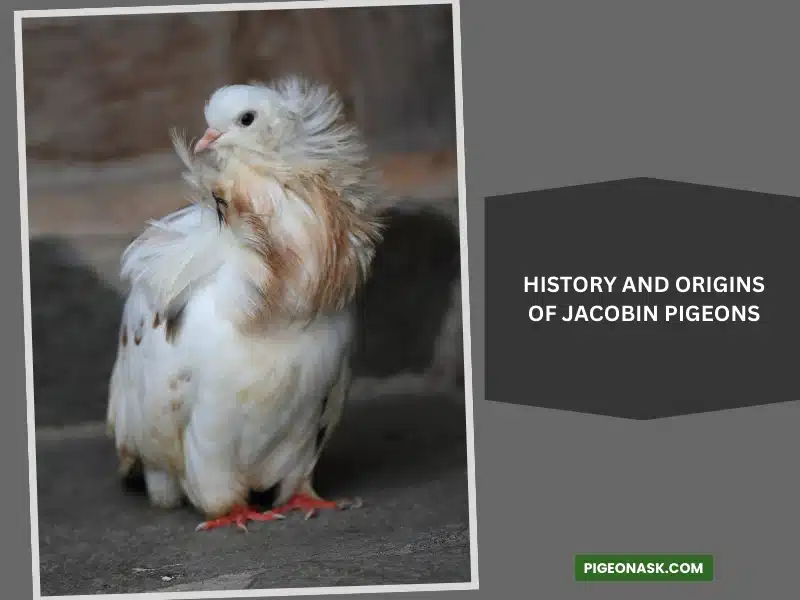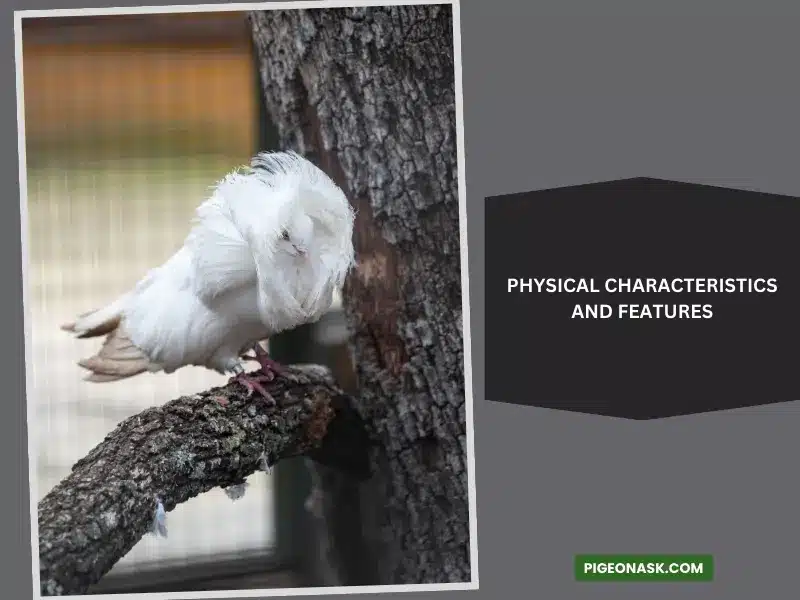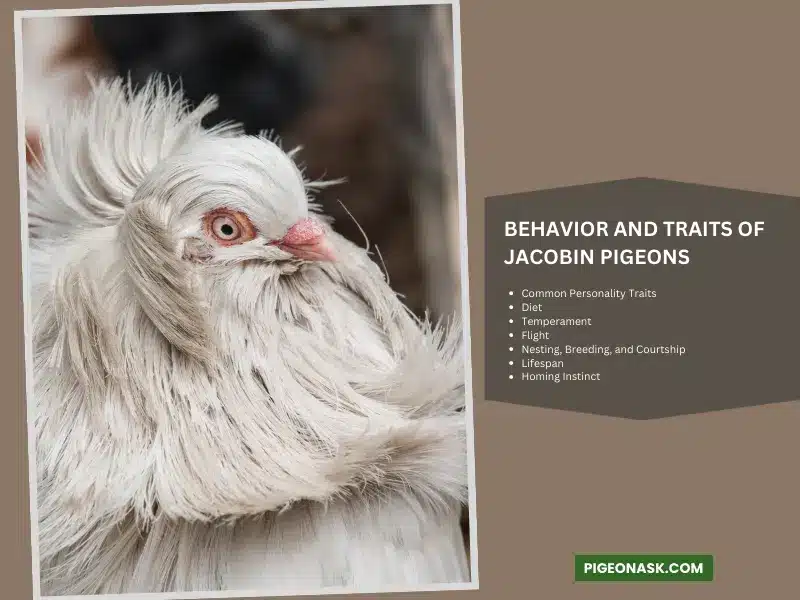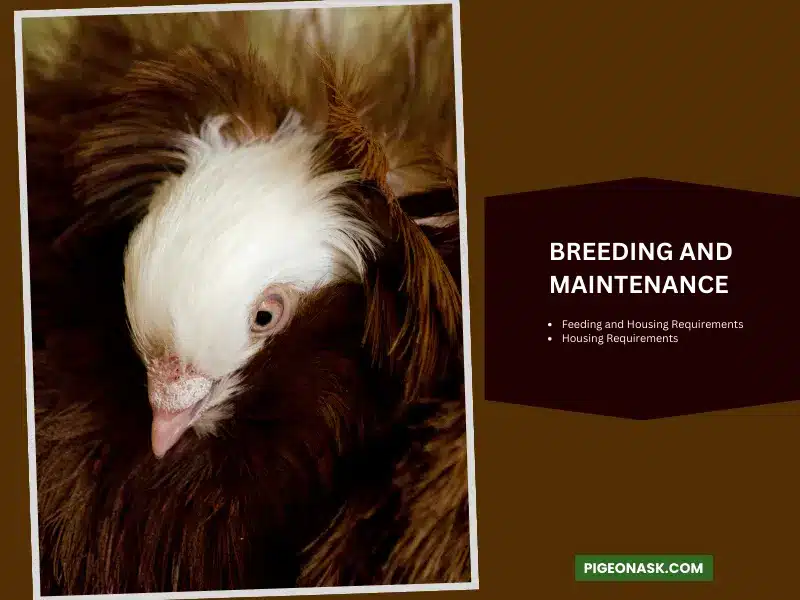Jacobin Pigeon: Behavior And Breed Guide (With Infographic)
If you look for fancy pigeons, the Jacobin pigeon is the fanciest of them all. After all, the feathered hood over the head is easily recognized worldwide.
Jacobin pigeons went through years of selective breeding to develop their current look. They’re great for exhibition, show, and ornamental purposes. Since Jacobins are a domesticated breed, they don’t have strong homing or flight capabilities. Plus, Jacobins require plenty of maintenance, meaning they’re not suitable as pets.
There are many more interesting facts about this breed, and that’s the reason for this article. Here, you will learn everything there’s to know about them, how to breed them, and under what conditions to raise them.
Jacobin Pigeon Profile:
| Name | Jacobin Pigeon |
|---|---|
| Scientific Name | Columbia livia |
| Common Names | Culbutan Jacobin |
| Origin | India |
| Size | 14 inches |
| Weight | 350 grams |
| Lifespan | Ten years |
| Physical Features | Slender and sleek body, with longs week and featherless legs |
| Temperament | Territorial |
| Behavior | Aggressive during the breeding period Indifferent to humans |
| Special Features | The feathered hood over the head |
| Breeding and Maintenance | Complicated |
| Common or Popular Varieties | Multiple colors |
Overview
The Jacobin pigeons are a breed of fancy birds with alleged origins in Asia.
They can be different colors, and their most characteristic trait is the feather arrangement on their heads. Generally, Jacobin birds are a show breed and also ornamental use.
Looking for more articles about pigeon breeds:
History and Origins of Jacobin Pigeons
Jacobin pigeons originated in Asia, and the breed went through many stages before they looked like modern Jacobins. Here’s what we know about their history.

The History and Origin of Jacobin Pigeons
This type of pigeon is a descendant of the rock pigeon, also called Columbia livia. Breeders used selective breeding to develop Jacobin pigeons, a technique first employed as early as 1500.
Then, explorers and traders brought Jacobins to Europe during the 16th century.
However, records indicate that the breeding of these pigeons went through four stages before becoming what they are today.
Where Did the Jacobin Pigeon Come from?
The Jacobin pigeon comes from India and is a breed of fancy birds for domestic use. Interestingly, the birds got the name because the British believed the feathered hood resembled the hoods worn by Jacobin monks.
Physical Characteristics and Features
This breed of pigeon stands out from the rest because of its unique physical characteristics and features. Here, we break down these features to help you understand the pigeons better.

Appearance
Looking at the bird closely, you will notice they’re slender and sleek. The wings are super long, and they don’t have any feathers on the legs.
With that said, the stylish feathers and the magnificent hood covering their heads make Jacobin the fanciest show bird. The unique appearance of Jacobin pigeons is why many countries worldwide breed them using selective methods.
Size and Body Structure
The appearance of Jacobin pigeons can be a bit deceiving. While the fluffy feathers make the birds look big, they’re actually small to medium.
How Big are Jacobin Pigeons? In reality, the body of a Jacobin can be as tall as 14 inches.
Weight
A fully grown Jacobin can weigh approximately 350 grams. While raising them, it’s necessary to monitor their weight to ensure they’re growing up healthy.
Plus, it will help identify if the pigeon is eating well. Remember that during breeding, male Jacobins may prohibit other males from feeding.
Unique Features
Jacobin pigeons have one particular feature that makes them a unique breed. That feature is the hood of feathers covering their heads, which extends to the neck and shoulders.
This hood is quite particular, as the feathers grow backward and give the pigeon a ruffled look.
And this unique feature is a noticeable difference from other breeds, and it means that these pigeons require more grooming and attention.
Some Common Variations in Colors and Markings
Breeders have developed Jacobins in multiple colors, including white, black, yellow, silver, red, and blue. In Australia, the most popular Jacobins are black, white, red, and yellow.
Likewise, breeders have attempted to create Jacobins with longer necks to create a hood held by the shoulders. However, birds with heavier shoulders proved to have higher-quality feathers.
Behavior and Traits of Jacobin Pigeons
A thorough evaluation of Jacobin’s behavior and personality traits shows us that this breed of pigeons is complex-natured.

Thus, it’s necessary to understand how they usually act to create the ideal living conditions for them.
Common Personality Traits
Jacobin pigeons are an intriguing breed of birds due to their personality. They’re beautiful and fascinating but also complicated and can be troublesome.
For example, females and males are selfish, and males can be aggressive toward other males during breeding. Therefore, it’s super necessary to keep the mating pair alone.
Otherwise, they will fight against each other once the breeding male attempts to claim ownership of the space by standing over the cages.
Humans don’t have it any easier. While other breeds can be gentle and loyal to breeders, Jacobins don’t have the same affection.
Female Jacobins are not as aggressive, though. They’re more suitable as pets, especially with children in the household.
Diet
Jacobin pigeons can grow healthy by eating regular pigeon food. So, raising this breed is not expensive. You can feed them seeds, fruits, vegetables, and nuts.
Similarly, you can add wheat, rice, legumes, raisins, grapes, and blueberries. If you want to treat your Jacobins, you could also introduce small insects, snails, and worms periodically.
Additionally, this breed of pigeons needs vitamins, proteins, and minerals to enrich their diet. Thus, it’s necessary to feed them commercial pigeon food to provide these nutrients.
Temperament
Jacobin pigeons may look innocent, but they’re highly territorial birds.
During the breeding phase, the male will claim the cage floor and take control of the area. As a result, others may struggle to eat because they may not have access to the food.
For this reason, designating breeding boxes for each pair is the most logical approach to prevent aggression or other problems.
Flight
Jacobin pigeons are surprisingly decent flyers. In the open, they can fly for a few meters before taking a rest.
One thing that makes this breed particularly popular is the graciousness of their flight. In the air, the Jacobin performs spins, tumbles, and flips.
Even then, the Jacobin specie is not capable of flying long distances. Once they need to take a pause, they fly to a nearby treetop or terrace.
Nesting, Breeding, and Courtship
The Jacobin male and female usually prefer mating before or during the summer, usually around the end of July. This phase is relatively easy for breeders.
All you have to do is create the right conditions and place the pair together. Following the mating, the female will lay one, wait for a day, and produce another.
Generally, this period results in three batches of two eggs per breading. Then, the female will sit on the eggs, which take 18 to 20 days to complete the hatching.
Where Do Jacobin Pigeons Live? Jacobin pigeons can live under all climate conditions, creating flimsy nests in locations like buildings or trees. The female Jacobin builds the nest using straws or shredded paper.
Therefore, it’s necessary to provide these materials while breeding.
Lifespan
Jacobin pigeons can live for ten years under the right conditions. Luckily, this breed of bird isn’t vulnerable to any particular disease.
The most likely threat to these pigeons is Chronic Respiratory Disease (CDR), but this ailment is easy to identify, and vets can address it quickly.
Homing Instinct
The homing ability of Jacobin pigeons is poor. They will find their way back home, but only if the distance is short. Otherwise, they’re more likely to get lost or fly away.
Breeding and Maintenance
After learning about them a bit more, the next question to address is what are the necessary care requirements for a Jacobin pigeon? In this section, we address this issue with many details and a few tips.

Some Tips and Considerations for Successful Breeding
Keep the following information in mind while breeding Jacobins to increase the likelihood of success.
#Trim feathers from the cowl. The feathered hood looks beautiful, but it can become a problem for the birds.
#Watch out for the eggs. The muffs in the females may not allow them to look back, which is an issue. Sometimes, an egg may slide off, and they won’t notice.
#Use sand in the housing, not sawdust. This way, the cage or box floor won’t blow around, and keeping the area clean will be easier.
#Separate the mating pair from other birds during the breeding season. If you don’t, the males may have conflicts.
#Change the food and water supply daily. Birds are picky, and they won’t eat leftovers.
Feeding and Housing Requirements
While raising Jacobins, you must create a balanced diet filled with proteins, vitamins, and minerals. When the chicks are young, you must take special care of them to ensure they eat well. This is because they have short beaks that complicate feeding the baby birds.
Also, don’t forget to provide fresh, clean water. Make sure the water supply is constant and always available. Otherwise, the birds may suffer illnesses or other conditions.
Housing Requirements
Housing is equally important to guarantee the Jacobins live and breed successfully. Since they need their own space, a 4x6x6 feet area should be spacious enough.
Frequently Asked Questions
1. Is Jacobin pigeon endangered?
No, the Jacobin pigeon is not part of the endangered species.
2. Are Jacobin pigeons good pets?
The male Jacobin pigeons can have an aggressive temperament and are not suitable as pets. For this reason, only enthusiasts and breeders should take care of these pigeons. The birds also require plenty of maintenance and grooming, something not everyone is willing to do.
3. Why Are Jacobin Pigeons So Popular?
Jacobin pigeons are particularly popular due to the feathered hood they grow over their heads. This feature is one of the first things you notice about the breed, as it’s a characteristic not seen on other birds. That’s one of the reasons they make excellent exhibition birds.
Final Word
Beautiful and captivating, the Jacobin pigeon is a breed that every bird enthusiast or breeder wants to have.
But if you want one as a pet, you may want to look for other pigeons instead of this. Otherwise, few other birds are as good-looking as the Jacobin, which makes them an attractive show bird.
Found this article interesting? Don’t miss out on more articles like this and way more interesting facts about the bird world. Check out our socials on Facebook, Twitter, and Pinterest to keep yourself updated!
Image Credit:
- Canva.com/photos
